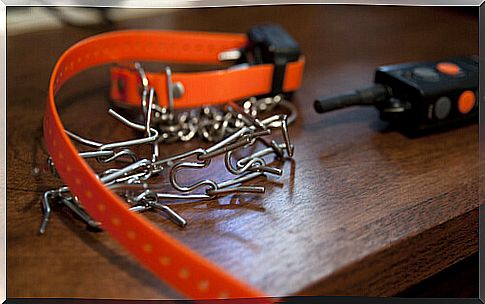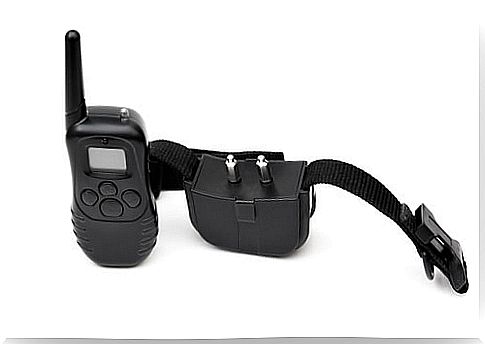Punishment Collar Problems: Your Dog’s Health Is At Stake

Some people still use training collars to solve their dog’s behavior problems. However, these tools are prohibited in several countries because they cause more harm than good, so we want to detail here the problems of punishment collars and how they affect the health of your dog.
What are necklaces of punishment
Punishment collars, also called training collars, are a series of collars or devices that are placed on the neck of dogs. When the dog does something wrong, the collar hurts him, with the intention of making him stop doing it: pulling on the leash, barking, or being reactive in front of another dog, for example.
These necklaces, however, do not solve these behaviors: they only seek to inhibit the symptom, but at no time do they provide a solution to its root. Dogs can bark for many different reasons, just as they can pull on the leash for different reasons. Punishing the dog when it does something we do not like is not teaching it: to teach it, we must show it the behavior we do want.
The neck of the dogs
All collars are located in the throat of dogs: as for all mammals, it is a delicate area of the body and key in their neuronal and hormonal development. The throat is not only a soft boneless structure, it also contains many hormone-secreting glands, such as the thyroid. Also, some of the main nerves in the spinal cord branch in the neck.
Wearing training or punishment collars has been shown to cause ongoing stress: stress increases cortisol levels. Cortisol causes a bad mood, decreases the hormones that facilitate rest, calm and happiness. This translates into an inability to rest, irritability, and a heightened emotional state: hence, worse self-control and, in our eyes, worse behavior.
Spiked Punishment Necklaces Issues
Spike collars, as the name suggests, have spikes that dig into the dog’s neck. One of the problems with punishment collars is that, although some have a plastic protector on the spikes, this does not prevent them from doing damage.
These collars can cause skin injuries and even wounds: the spikes sometimes pierce the skin, and also cause continuous friction against the dog’s neck. The pressure against the windpipe causes a chronic cough and tracheal collapse, which affects the ability of dogs to breathe, even preventing them from breathing all the oxygen they need.

The spikes continuously pressing against the hormone-secreting glands alter their normal functioning: thyroid problems appear and, therefore, metabolic problems; The lymphatic and circulatory systems can also be affected and autoimmune diseases appear.
It is common to find contractures and other back injuries in dogs that wear tight collars and leashes; the percentage shoots up when the necklace is also one of spikes. Pain not only affects the well-being and quality of life of animals, as it also affects behavior, causes fear and perhaps leads to aggressiveness.
Health problems caused by electric necklaces
Electric collars send an electric shock through the dog’s neck. Some have different voltage levels and even the option to send only a vibration: in all cases it is painful, annoying and confusing for the animals, because if not, they would not be effective.

In addition to all the problems mentioned in the previous section, the electric current branches throughout the body: nerves are located in the throat that connect directly with the spinal cord, and, therefore, with the rest of the body and the brain. An electric shock to the neck has repercussions throughout the body.
Health problems caused by citronella necklaces
Fortunately, they are rare, but there are devices that spray an aerosol, usually made up of citronella, directly into the dog’s nostrils. Smell is the fundamental sense of dogs and the nose is a sensitive organ.
Applying a product as aggressive as an aerosol in this place can irritate the mucous membranes or alter their normal functioning, drying out or producing excessive moisture, causing pain and loss of sensitivity. It could even damage the scent glands, preventing the dog from exploring the world normally and affecting its communication with other dogs.
Smell for dogs is essential for their well-being: through it they explore the world and communicate with other animals. A dog without smell not only cannot be happy: another problem with punishment collars is that a dog without smell cannot have quality of life.
Psychological problems derived from the use of these necklaces
These necklaces not only have physical consequences: also psychological. Punishments in training a dog do not work, and they usually make the behavior that was intended to be avoided worse.
The continued use of punishment causes insecurity, stress and fear. These are accentuated if they are also accompanied by a sensation of pain. Fear and stress are the most frequent causes of aggression in dogs, and are the great triggers for attacks and bites.

The psychological damage caused by wearing these necklaces can be very difficult to reverse. The bad associations you make during your training with these collars can be impossible to erase.
Finally, punishments do not solve the root of the dog’s behavior problem. In addition, on many occasions, the dog does not understand why he is being punished. By wearing these collars you are not providing any useful information about what your behavior should be.
These tools should be ruled out early on in dog education or training. They are dangerous in the short, medium and long term; and the problems of punishment necklaces are not always reversible. Theories of education have come a long way in recent decades and, fortunately, today there are other techniques that are faster, safer, more reliable and easier to use.









